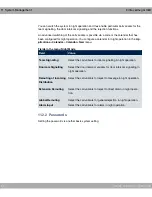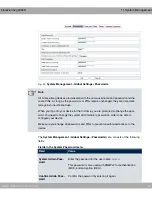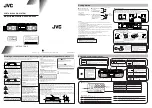
Bridging connects networks of the same type. In contrast to routing, bridges operate at lay-
er 2 of the OSI model (data link layer), are independent of higher-level protocols and trans-
mit data packets using MAC addresses. Data transmission is transparent, which means the
information contained in the data packets is not interpreted.
With routing, different networks are connected at layer 3 (network layer) of the OSI model
and information is routed from one network to the other.
Conventions for port/interface names
If your device has a radio port, it receives the interface name WLAN. If there are several ra-
dio modules, the names of wireless ports in the user interface of your device are made up
of the following parts:
(a) WLAN
(b) Number of the physical port (1 or 2)
Example:
A8"
The name of the Ethernet port is made up of the following parts:
(a) ETH
(b) Number of the port
Example:
(
The name of the interface connected to an Ethernet port is made up of the following parts:
(a) Abbreviation for interface type, whereby
stands for internet.
(b) Number of the Ethernet port
(c) Number of the interface
Example:
(first interface on the first Ethernet port)
The name of the bridge group is made up of the following parts:
(a) Abbreviation for interface type, whereby
;$
stands for bridge group.
(b) Number of the bridge group
Example:
;$
(first bridge group)
The name of the wireless network (VSS) is made up of the following parts:
Abbreviation for interface type, whereby
6--
stands for wireless network.
(a) Number of the wireless module
(b) Number of the interface
11 System Management
bintec elmeg GmbH
94
elmeg hybird 120 / hybird 130
















































